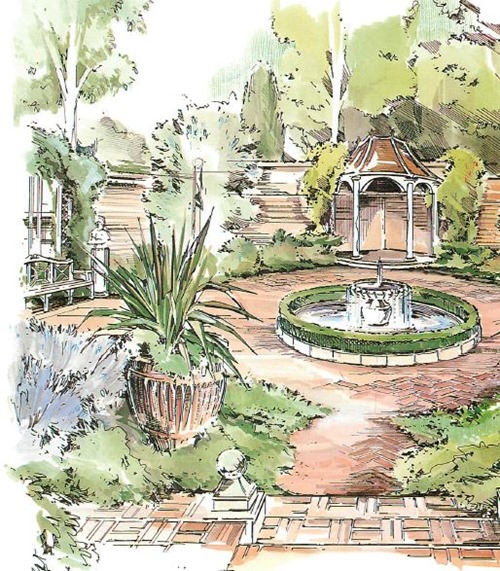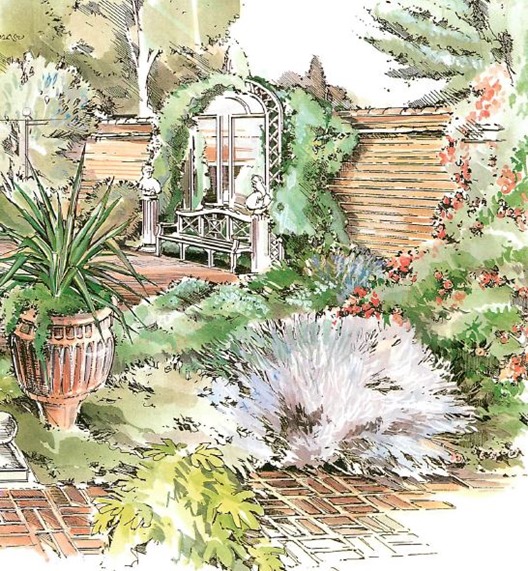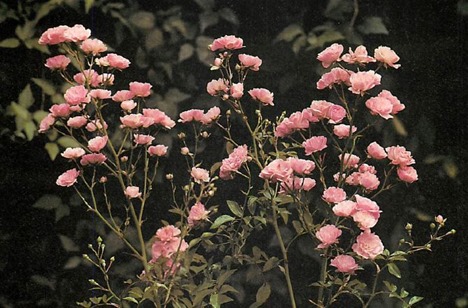





Whatever your dreams, it’s good to have them and although everyone’s dreams are different, if money were no object, children and pets did not need to be taken into consideration, and one lived in a world where afternoon tea was served on a silver tray, one might wish for a garden on the symmetrical and formal lines of this design. I drew this for a friend who sadly was gazumped on the house and the garden remained a drawing in a sketching pad. Not that I aspire or, I must hasten to add, wish to be a garden designer.
The garden, excluding the 30 ft by 70 ft (9 m by 21 m) terrace, was a walled garden 90 ft (27 m) deep and 70 ft (21 m) wide, a substantial amount of space for a Georgian town house garden.
Standing on the terrace, the garden’s formal shape with its blue and white planting scheme unfolds before you and your eye is immediately drawn to the fountain on the far side of the two large upright stone urns with yuccas or cordylines growing in them, with camellias planted on the right where they do not get morning sun and other flowering shrubs on the left. Built against the back wall which is covered with Magnolia grandiflora, wisteria and ‘Bobbie James’ climbing roses, a half pagoda in the centre dominates the far end of the garden. Three crescent-moon stone steps lead to the throne-like sitting area where table and chairs are set out under the green copper or lead canopy roof and look out over the bold stone fountain in the circular pond, edged by stone and surrounded by a low box hedge in the middle of the garden itself. The fountain makes a strong focal point and helps to screen the garden beyond.


On either side of the fountain, against the wall, are two huge mirrors framed by a classical trellis arch giving the impression the garden has more width than it actually has, and creating the illusion that one can leave the garden and walk beyond its four walls. The mirror also reflects the fountain and adds yet another dimension to the garden. The four busts, each placed on a 3 ft (90 cm) column entwined with ivy, stand elegantly on either side of the mirror, punctuating the arbour with architecture rather than horticulture. These statues or busts make an even stronger statement when lit at night.
The herring-bone brick path that weaves round the fountain marries the four areas together. The path starts at the top of the steps at the entrance to the garden proper and continues between the jardinieres, round to the first sitting area on the left in front of the first mirror which enjoys the morning sun, then on to the pagoda to catch the majority of the sun from midday onwards, finally arriving at the third sitting area in front of the second mirror, where you can watch the sun set behind the trees. As dusk envelops the garden you can admire it being dramatically transformed by lighting when the busts or statues, pagoda, fountain and plants will all take on a new dimension.
The basket-weave brick terrace near the house has a traditional elegance all of its own, the detail on either side creating interest in areas which otherwise could be confining brick walls. Again a tall arch is created with a trompe l’oeil trellis and statue, or small bay tree, or half-standard rose, or flowering shrub planted in a stone jardiniere in front. The small, raised, curved brick flower bed at the bottom of the trellis, is filled with variegated Enonymus fortunei periwinkle cascading over the edge of the brick work with sweet-smelling jasmine and Felicite et perpetue rambler rose growing on the wall round the arch, but leaving the trompe I’oeil trellis with the urn and shrub in front. A selection of stone jardinieres are arranged around the terrace with sweet-smelling summer bedding plants and half-standard ‘The Fairy’ rose, introducing pink into this area of the garden. The quiet colour scheme of the rest of the garden is white and cream with a little blue introduced here and there to soften the edges.
Walled Garden with Copper Roof Pagoda
White and blue colour scheme with a little pink introduced on the terrace near the house.
T = Trouble free
T Magnolia grandiflora ‘Goliath’. To grow up the back wall on either side of the pagoda.
Magnificent slow growing evergreen shrub. Grows to 20 ft (6 m) or more but can grow much taller in the south of France or Italy. Best against a sheltered wall. Glossy dark green leaves with felly brown undersides. Very large waxy creamy white pungently scented flowers between July and September.
Or
T Betula pendula ‘Tristis’ (Weeping birch). White bark. Tall and narrow with pendant branches.
Yellowish green catkins in spring. Small light green leaves which flutter in the breeze and make this appear a very ‘light’ tree. Height 25ft (8m).
T Eucalyptus niphophila. Can grow to 30 ft (9m). Soft grey evergreen leaves. This fast-growing tree looks good in all seasons and the leaves are excellent for cutting for flower arrangements. Develops an attractive white trunk with age. Needs sunny position.
T Ginkgo biloba (Maiden hair tree). Primitive slow-growing deciduous tree. Eventual height 50ft (15 m plus). Spread 10 ft (3 m). Small leathery fan-shaped pale green leaves in spring, turning darker in the summer and golden in the autumn. Or
Ficus carica, Moraceae (Fig). A good tree to grow against a south-facing wall in a sheltered garden. They are not strictly low-maintenance as they need to be pruned and trained if growing against a wall. They add a period elegance to a garden, in the same way a Ginkgo or Magnolia grandiflora do.
Many trees and shrubs have a modern look, so in a Georgian garden ‘old’ trees help to give a garden atmosphere. If the fig is planted against a sheltered wall it can survive in the north. Height 8- 10ft (2.5-3m). Spread 12- 15ft (3.5-4.5m). But a free-growing bush will grow in the south to 12- 15ft (3.5-4.5m) and spread 8- 10ft (2.5-3m). Dark green glossy leaves. The fig tree will look interestingly gnarled after its leaves have fallen each autumn.
T Syringa vulgaris ‘Katherine Havemeyer’ (Lilac). Hardy deciduous late-flowering shrub. Height 8- 12ft (2.5-3.5m). Spread 5-8ft (1.5-2.5m). Strongly scented double purple/lavender flowers in May. Or, S.v. ‘Vestale’, which has single white flowers in late May. Prefers sunny position.
Carpentaria californica. Quite hardy evergreen shrub. Can grow to 6ft (1.8m). Spread 5-8ft (1.5-2.5m). Glossy dark green leaves and pure white single open-faced poppy-like flowers in June and July. Most attractive plant when in bloom. Accepts hard pruning from time to time. Needs sunny position.
T Viburnum plicatum tomentosum ‘Mariesii’. Stunning white flowering deciduous shrub. Height 6ft (1.8m). Spread up to 10 ft (3m). Horizontal tiered growth which becomes a mass of 2-3 in (5-7.5cm) flat heads of white long-remaining flowers in May. One of the most handsome of the wonderful viburnum family! Tolerates sun or shade. The leaves often go reddish purple in October. Plant as a feature.
Hydrangea macrophylla ‘Blue Wave’ (Lace cap hydrangea). Deciduous shrub. Height and spread 5ft (1.5m). Mid green leaves. Pretty delicate flat florets of blue sterile flowers 4 in (10 cm) across in June. (Needs acid soil to remain blue). Best in shade.
Hydrangea villosa (Lace cap). Deciduous shrub, up to 6ft (1.8m) tall and rather upright. Large, rough, mid-green leaves and lace-cap heads with blue florets even on alkaline soil. Needs good soil and half shade.
Skimmia japonica ‘Fragrans’ and ‘Foremanii’. Excellent hardy evergreen dark leafed shade-loving shrub. Slow-growing. Height 3—4ft (90cm- 1.2m). Spread 4-5ft (1.2-1.5m). Cream white fragrant flowers in spring followed by red berries on female plants.
T Itea ilicifolia. Evergreen shrub, holly-like leaves. Masses of long drooping racemes, rather catkin-like produced in late summer, pale green flowers. Height 6ft (1.8 m).
T Garrya elliptica ‘James Roof (Silk tassel bush). Evergreen shrub. Can grow to 8- 10 ft (2.5— 3m) and spread 6- 12 ft (1.8-3.5m). Male form is laden with 9- 12 in (22.5-30 cm) long catkins in February/March. Thick leathery grey/green leaves. Ideal in walled garden as it is vulnerable to very cold winters. Shade-loving.
The two plants above will complement each other as one set of catkins will be followed by another.
T Hebe andersonnii ‘Variegata’. Evergreen flowering shrub. Height 3 ft (90cm). Spread 2-3ft (60-90cm). LavenderJiowers 3-5in (7.5-12.5cm) long from June to October. Leathery cream and mid green leaves. Not very hardy but easy to root from cuttings in summer. Sunny position.
T Euonymus fortunei ‘Silver Queen’. Evergreen shrub. Glossy, very white and very green leaves. Height 2 ft (60cm). Spread 5ft (1.5m). Most useful and attractive creeping ground cover. Small greeny white flowers in May /June. (Will climb a wall or look really good growing through a dark conifer.)
T Lavandula spica (Lavender). Hardy evergreen shrub. Height I-2ft (30-60cm). Spread 2-3 ft (60—90 cm). Aromatic grey/green oblong leaves and blue/purple fragrant flowers July to September. Replace every 6 to 10 years. Cut back last year’s growth only each year to keep it bushy.
T Cordyline (Cabbage palm). Striking plant for stone urn and surrounded by variegated Vinca or Osteospermum ecklonis. Evergreen palm-like shrub. (Needs to have its spiky long slim mid-green leaves tied up in winter to protect it from the frost.)
Or
Yucca which is a hardy evergreen and has a slightly less attractive spiky habit than Cordyline, but a Yucca does not need to be protected front the frost.
Wisteria floribunda ‘Alba’. To grow over the copper roof of the pagoda. (Not suitable over a slate roof as its vigorous growth soon works its way under the slates and causes expensive damage unless it is kept well under control.) ‘running climber, not as vigorous as the blue variety. White flowers appear April/May before mid green foliage has unfurled. Can grow to 25-30ft (8-9m) against a wall.
T Rosa ‘Bobbie James’ (Rambler). For back wall. Vigorous rambler. Grows to 25ft (8 m). Glossy pale green leaves. Large clusters of semi-double small white flowers with yellow stamens in June and July. Prefers sunny position. Beautiful fragrance. Or ‘Alberic liarbier’, another excellent rambler with some flowers in autumn, tolerates shade or sun.
T Hedera colchica ‘Dentata Variegata’ (Persian Ivy). Handsome large-leafed variegated vigorous ivy to climb round the column of the statues and up the wall. Can climb up wall to 20-30 ft (6-9 m) if you let it. Vigorous and easy once established.
T Jasminum officinale Affine. Hardy deciduous twining climber. Can grow to 30ft (9m). Small mid-green leaves. Scented white flowers Jutie to October. Most undemanding plant and will quickly clothe a wall. Prefers sun for more flowers.
T Clematis macropetala. Grows to 12ft (3.5m). Drooping, starry, blue flowers on old wood May/ June so doesn’t need cutting back. Tolerates shade or sun.
T Hydrangea petiolaris. Near the house. Can grow to 30ft (9m) on a suitable wall. Excellent, undemanding, self-clinging climbing hydrangea on moist wall; otherwise it needs ties to keep it on target. White flowers all summer. Mid to dark green leaves with brown flaky stems. Prefers shade. Easy plant to prune.
T Rosa ‘Felicite et Perpetue’ (Climbing rose). Reliable rambler. Handsome rose in June and July. Clusters of small white flowers, each a perfect rosette, buds tinged with red before they open. Glossy dark green leaves. Splendid on a north wall. Therefore ideal to go over the trellis mixed with jasmine in the alcoves on either side of the terrace. Grows to 15 ft (4.5m). This rose prefers little or no pruning. Hard pruning will result in less flowers. Cut out old stems to the ground when they do not flower well. Tolerates shade or sun.
T Camellia X williamsii ‘Francis Hanger’, with single white flowers which start in November and continue till April, shiny dark green leaves and upright growth to about 6 or 8ft (1.8-2.5m), are also excellent plants for this garden. This is a true low maintenance plant as its flowers fall when they fade, but camellias do not like to be planted where they get the early morning sun. They must have an acid soil that is not too heavy but retains moisture in summer. Top dress camellia roots each autumn with peat.
T Euphorbia characias wulfenii. Magnificent sub-shrub. Hardy (in sheltered position). Height and spread 2- 4ft (60 cm- 1.2 m). Masses of grey/green leaves on semi-woody stems. Tall spikes of greenish yellow bracts in winter and spring. This is more than just a plant. This decorative species is a statement and has a tremendous impact when in flower.
T Stachys lanata (Lambs’ tongues). Hardy herbaceous perennial. Mat forming spreading habit. Height lft to 18 in (30-45 cm). Soft grey/green hairy or woolly leaves. Woolly spikes of purple flowers in July. Good summer ground cover and ideal affront of border.
T Alchemilla mollis (Ladies’ Mantle). Charming perennial which makes excellent summer ground cover. Vigorous plant once established. Light green flat leaves. Tiny star-shaped yellowish green flowers June to August. Height lft-18 in (30-45cm). Easily divided. Can seed itself and may become too big. Tolerates shade or sun.
Zantedeschia aethiopica ‘Crowborough’ (Arum lily). (Either side of the pagoda steps.) Hardy bulbous plant. Needs moist soil. Large white upward-facing trumpet flowers, height 2ft (60 cm). Evergreen leaves (except in severe winter conditions). Handsome flowers from March to June. Prefers a sunny position.
T Hosta sieboldiana ‘Elegans’ and Hosta fortunei ‘Aureomarginata’. Hardy herbaceous perennial. Excellent shade-loving, summer grown cover with attractive foliage. H.s. ‘Elegans’ – height 2ft (60cm). Large blue/ grey leaves. Pale lilac flowers from July to August. H.s. ‘Aureomarginata’ (long stalked hosta). Grey/ green leaf with narrow gold edge. Lilac flowers July. Tolerates sun or shade – always good value.
T Campanula carpatica ‘White Star’. Low-growing hardy perennial. Mid-green leaves. Height 8-12in (20-30cm). Spread 12-15in (30-40 cm). Ideal for the front of a border. Pure white flowers in June and July. Prefers sun.
T Convallaria majalis (Lily of the valley). Hardy herbaceous perennial. Delightful sweet smelling small white flowers in May. Slim darkish-green leaf. Height 10 in (25cm). The lily of the valley is a joy and a surprise each year. The leaves are slow to die down. Prefers shady position.
Tulipa turkestanica. Wild species from central Asia. Grows to 8 in (20cm). Narrow grey leaves. Small white flowers with yellow centre and green tinge (needs sunny position and good drainage), and Tulipa Schnoord. Lovely double white early flowering tulip. Height 12-15in (30-40cm). Grey/green leaves.
T Nepeta faassenii (sometimes listed as mussinii) ‘Six Hills Giant’. This wonderful perennial is a must in any border. Its haze of blue/ lilac flowers from May to September grows to 18-24 in (45-60 cm) and can spread as far or more in good soil. The grey/green leaves remain throughout mild winters.
Anemone japonica or elegans ‘Honorine Jabert’ or ‘White Queen’ (Japanese anemone) Herbaceous perennial. White flowers shoot up from nothing to 4ft (1.2 m) to flower on long stalks in late summer.
T Polygonatum multiflorum (Solomon’s Seal). Elegant herbaceous perennial. Excellent in the shade. Height 2-4ft (60cm-1.2m). Oblong mid-green leaves on arching stems, with drooping white flowers along the stem in clusters in June. Shade loving.
Iris sibirica ‘Blue King’ (Beardless Iris). Grows to 3-4ft (90 cm- 1.2 m). Mid-green evergreen leaves in solid clumps. Blue flowers mid-June. Also Iris pallida dalmatica ‘Argenteo Variegata’ (Tall bearded iris). Dark blue flowers June/July. Plant in sun. Grey/blue leaves with white stripes.
T Geranium ‘Johnson’s Blue’. Hardy herbaceous perennial. Grows to 8 in (20 cm). Excellent summer ground cover. Soft blue flowers May to October. Delicate mid-green leaves. Useful hardworking and pretty plant.
T Pulmonaria saccharata or P.s. ‘Argentea’. Hardy herbaceous perennial. Dramatic plant. Shade tolerant. Large green leaves with white/silver blotches on it. White/sky blue flowers in March/ April. Grows to 1ft (30 cm).
 T Helleborus niger (Christmas Rose), appealing evergreen, shade-loving ground cover with white flowers from December to March.
T Helleborus niger (Christmas Rose), appealing evergreen, shade-loving ground cover with white flowers from December to March.
For the terrace:
T Half standard rose ‘The Fairy’ in large container. Ivy and Aubretia planted round the base and under planted with spring bulbs. ‘The Fairy’ is a late flowering modem shrub rose with tiny dark green leaves. Flowering starts and finishes later than most roses. Sprays of small soft pink flowers.
Underplant the beds with clumps of hardy miniature cyclamen ‘atkinsii’, snowdrops, grape hyacinths, narcissi and other white and blue bulbs.
Copyright © www.100flowers.win Botanic Garden All Rights Reserved